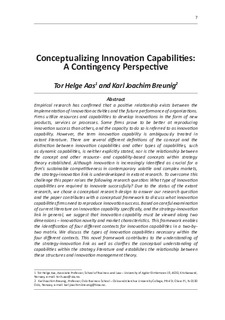| dc.contributor.author | Aas, Tor Helge | |
| dc.contributor.author | Breunig, Karl Joachim | |
| dc.date.accessioned | 2018-02-13T11:39:49Z | |
| dc.date.available | 2018-02-13T11:39:49Z | |
| dc.date.created | 2017-09-14T16:06:04Z | |
| dc.date.issued | 2017 | |
| dc.identifier.citation | Journal of Entrepreneurship, Management, and Innovation. 2017, 13 (1), 7-24. | nb_NO |
| dc.identifier.issn | 1734-283X | |
| dc.identifier.uri | http://hdl.handle.net/11250/2484350 | |
| dc.description.abstract | Empirical research has confirmed that a positive relationship exists between the
implementation of innovation activities and the future performance of organizations.
Firms utilize resources and capabilities to develop innovations in the form of new
products, services or processes. Some firms prove to be better at reproducing
innovation success than others, and the capacity to do so is referred to as innovation
capability. However, the term innovation capability is ambiguously treated in
extant literature. There are several different definitions of the concept and the
distinction between innovation capabilities and other types of capabilities, such
as dynamic capabilities, is neither explicitly stated, nor is the relationship between
the concept and other resource- and capability-based concepts within strategy
theory established. Although innovation is increasingly identified as crucial for a
firm’s sustainable competitiveness in contemporary volatile and complex markets,
the strategy-innovation link is underdeveloped in extant research. To overcome this
challenge this paper raises the following research question: What type of innovation
capabilities are required to innovate successfully? Due to the status of the extant
research, we chose a conceptual research design to answer our research question
and the paper contributes with a conceptual framework to discuss what innovation
capabilities firms need to reproduce innovation success. Based on careful examination
of current literature on innovation capability specifically, and the strategy-innovation
link in general, we suggest that innovation capability must be viewed along two
dimensions – innovation novelty and market characteristics. This framework enables
the identification of four different contexts for innovation capabilities in a two-bytwo
matrix. We discuss the types of innovation capabilities necessary within the
four different contexts. This novel framework contributes to the understanding of
the strategy-innovation link as well as clarifies the conceptual understanding of
capabilities within the strategy literature and establishes the relationship between
these structures and innovation management theory. | nb_NO |
| dc.language.iso | eng | nb_NO |
| dc.publisher | National-Louis University, Wyzsza Szkola Biznesu | nb_NO |
| dc.relation.uri | http://www.jemi.edu.pl/uploadedFiles/file/all-issues/vol13/issue1/JEMI_Vol13_Issue1_2017.pdf | |
| dc.title | Conceptualizing Innovation Capabilities: a Contingency Perspective | nb_NO |
| dc.type | Journal article | nb_NO |
| dc.type | Peer reviewed | nb_NO |
| dc.description.version | publishedVersion | nb_NO |
| dc.source.pagenumber | 7-24 | nb_NO |
| dc.source.volume | 13 | nb_NO |
| dc.source.journal | Journal of Entrepreneurship, Management, and Innovation | nb_NO |
| dc.source.issue | 1 | nb_NO |
| dc.identifier.cristin | 1493894 | |
| dc.description.localcode | nivå1 | nb_NO |
| cristin.unitcode | 201,20,3,0 | |
| cristin.unitname | Institutt for strategi og ledelse | |
| cristin.ispublished | true | |
| cristin.fulltext | postprint | |
| cristin.qualitycode | 1 | |
